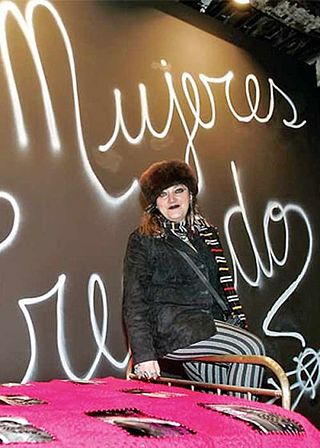
Yoko Ono is a Japanese multimedia artist, singer, songwriter, and peace activist. Her work also encompasses performance art and filmmaking.

Performance art is an artwork or art exhibition created through actions executed by the artist or other participants. It may be witnessed live or through documentation, spontaneously developed or written, and is traditionally presented to a public in a fine art context in an interdisciplinary mode. Also known as artistic action, it has been developed through the years as a genre of its own in which art is presented live. It had an important and fundamental role in 20th century avant-garde art.
Feminist theory is the extension of feminism into theoretical, fictional, or philosophical discourse. It aims to understand the nature of gender inequality. It examines women's and men's social roles, experiences, interests, chores, and feminist politics in a variety of fields, such as anthropology and sociology, communication, media studies, psychoanalysis, political theory, home economics, literature, education, and philosophy.

Carolee Schneemann was an American visual experimental artist, known for her multi-media works on the body, narrative, sexuality and gender. She received a B.A. in poetry and philosophy from Bard College and a Master of Fine Arts from the University of Illinois. Originally a painter in the Abstract Expressionist tradition, Schneeman was uninterested in the masculine heroism of New York painters of the time and turned to performance-based work, primarily characterized by research into visual traditions, taboos, and the body of the individual in relation to social bodies. Although renowned for her work in performance and other media, Schneemann began her career as a painter, saying: "I'm a painter. I'm still a painter and I will die a painter. Everything that I have developed has to do with extending visual principles off the canvas." Her works have been shown at the Los Angeles Museum of Contemporary Art, the Museum of Modern Art in New York, the London National Film Theatre, and many other venues.

Shigeko Kubota was a Japanese video artist, sculptor and avant-garde performance artist, who mostly lived in New York City. She was one of the first artists to adopt the portable video camera Sony Portapak in 1970, likening it to a "new paintbrush." Kubota is known for constructing sculptural installations with a strong DIY aesthetic, which include sculptures with embedded monitors playing her original videos. She was a key member and influence on Fluxus, the international group of avant-garde artists centered on George Maciunas, having been involved with the group since witnessing John Cage perform in Tokyo in 1962 and subsequently moving to New York in 1964. She was closely associated with George Brecht, Jackson Mac Low, John Cage, Joe Jones, Nam June Paik, and Ay-O, among other members of Fluxus. Kubota was deemed "Vice Chairman" of the Fluxus Organization by Maciunas.
Guerrilla Girls On Tour is an anonymous touring theatre company whose mission is to develop activist plays, performance art and street theatre addressing feminism and women's history. Formed when the original Guerrilla Girls split into three separate groups in 2001, Guerrilla Girls On Tour has performed in 17 countries and 39 US states with "Feminists Are Funny," "If You Can Stand the Heat: The History of Women and Food," "Silence Is Violence" and "The History of Women in Theatre, Condensed".

Feminist art is a category of art associated with the feminist movement of the late 1960s and 1970s. Feminist art highlights the societal and political differences women experience in their lives. The goal of this art form is to bring a positive and understanding change to the world, leading to equality or liberation. Media used range from traditional art forms, such as painting, to more unorthodox methods such as performance art, conceptual art, body art, craftivism, video, film, and fiber art. Feminist art has served as an innovative driving force toward expanding the definition of art by incorporating new media and a new perspective.
Gender essentialism is a theory which attributes distinct, intrinsic qualities to women and men. Based in essentialism, it holds that there are certain universal, innate, biologically based features of gender that are at the root of many of the group differences observed in the behavior of men and women.
Porn for women, women's porn or women's pornography is pornography aimed specifically at the female market, and often produced by women. It rejects the view that pornography is only for men, and seeks to make porn that women enjoy watching instead of what is being offered in male-centric mainstream pornography.
Hip hop feminism is a sub-set of black feminism that centers on intersectional subject positions involving race and gender in a way that acknowledges the contradictions in being a black feminist, such as black women's enjoyment in hip hop music and culture, rather than simply focusing on the victimization of black women in hip hop culture due to interlocking systems of oppressions involving race, class, and gender.
The feminist art movement refers to the efforts and accomplishments of feminists internationally to produce art that reflects women's lives and experiences, as well as to change the foundation for the production and perception of contemporary art. It also seeks to bring more visibility to women within art history and art practice. The movement challenges the traditional hierarchy of arts over crafts, which views hard sculpture and painting as superior to the narrowly perceived 'women's work' of arts and crafts such as weaving, sewing, quilting and ceramics. Women artists have overturned the traditional view by, for example, using unconventional materials in soft sculptures, new techniques such as stuffing, hanging and draping, and for new purposes such as telling stories of their own life experiences. The objectives of the feminist art movement are thus to deconstruct the traditional hierarchies, represent women more fairly and to give more meaning to art. It helps construct a role for those who wish to challenge the mainstream narrative of the art world. Corresponding with general developments within feminism, and often including such self-organizing tactics as the consciousness-raising group, the movement began in the 1960s and flourished throughout the 1970s as an outgrowth of the so-called second wave of feminism. It has been called "the most influential international movement of any during the postwar period."

Allyson Mitchell is a Toronto-based maximalist artist, working predominantly in sculpture, installation and film. Her practice melds feminism and pop culture to trouble contemporary representations of women, sexuality and the body largely through the use of reclaimed textile and abandoned craft. Throughout her career, Mitchell has critiqued socio-historical phobias of femininity, feminine bodies and colonial histories, as well as ventured into topics of consumption under capitalism, queer feelings, queer love, fat being, fatphobia, genital fears and cultural practices. Her work is rooted in a Deep Lez methodology, which merges lesbian feminism with contemporary queer politics.
Split Britches is an American performance troupe, which has been producing work internationally since 1980. Academic Sue Ellen Case says "their work has defined the issues and terms of academic writing on lesbian theater, butch-femme role playing, feminist mimesis, and the spectacle of desire". In New York City Split Britches have long standing relationships with La Mama Experimental Theatre Company, where they are a resident company, Wow Café, which Weaver and Shaw co-founded, and Dixon Place.
Feminist metaphysics aims to question how inquiries and answers in the field of metaphysics have supported sexism. Feminist metaphysics overlaps with fields such as the philosophy of mind and philosophy of self. Feminist metaphysicians such as Sally Haslanger, Ásta, and Judith Butler have sought to explain the nature of gender in the interest of advancing feminist goals.

Ewa Partum is a poetry artist, performance artist, filmmaker, mail artist, and conceptual artist.

María Galindo Neder is a Bolivian anarcha-feminist and psychologist. She has worked as a radio presenter and television host. She has written three books and is also a screenwriter.
Feminist activism in hip hop is a feminist movement based by hip hop artists. The activism movement involves doing work in graffiti, break dancing, and hip hop music. Hip hop has a history of being a genre that sexually objectifies and disrespects women ranging from the usage of video vixens to explicit rap lyrics. Within the subcultures of graffiti and breakdancing, sexism is more evident through the lack of representation of women participants. In a genre notorious for its sexualization of women, feminist groups and individual artists who identify as feminists have sought to change the perception and commodification of women in hip hop. This is also rooted in cultural implications of misogyny in rap music.
Li Xinmo is a Chinese feminist artist, art critic, and teacher. She graduated from the Department of Chinese Painting, and received her master's degree from Tianjin Academy of Fine Arts in 2008 and now resides in Beijing. She is a member of the German IO culture institution, vice president of Chinese and Germany culture communication organization. Li is mainly devoted to feminist theory and contemporary art criticism research. Her creation involves a series of issues such as gender, ethnicity, environment, and national politics. Her artworks are based on a variety of media, especially performance, photography and painting. Her works have been exhibited in major art galleries such as the Louvre in France, the National Museums of World Culture in Gothenburg, Sweden, and the Bonn Women's Museum in Germany. She also participated in Toronto Photo Biennial and Prague Art Biennial. Many museums such as the Taida Museum and the Museum of Far Eastern Antiquities in Sweden have some of her works.
Cut Piece 1964 is a pioneer of performance art and participatory work first performed by Japanese American multimedia avant-garde artist, musician and peace activist Yoko Ono on July 20, 1964, at the Yamaichi Concert Hall in Kyoto, Japan. It is one of the earliest and most significant works of the feminist art movement and Fluxus.
Jung Kang-ja was a South Korean visual artist. She was involved in the Korean avant-garde art scene in its formative years of the 1960s and early 1970s, during the repressive regime of Park Chung Hee. In this time she staged and participated in performances that challenged the contemporaneous artistic and cultural norms in South Korea.







